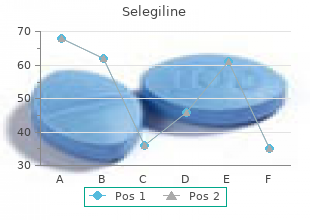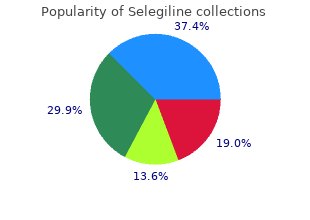Selegiline
"Purchase selegiline 5 mg otc, symptoms exhaustion."
By: Richa Agarwal, MD
- Instructor in the Department of Medicine

https://medicine.duke.edu/faculty/richa-agarwal-md
Additionally buy 5 mg selegiline free shipping treatment for depression, if there were a hemarthrosis present selegiline 5mg with amex medications for depression, adhesion can be expected to purchase selegiline 5mg with visa medicine tour form from the fibrinogen in the resolving blood clot cheap selegiline 5 mg without a prescription medicine pacifier. The exact cause of this “locking” can only be speculated, but it could be caused by a torn or separated meniscoid (all lumbar facets have menisci), a free fragment of articular cartilage, or simply roughness between degenerative joint surfaces. In fact, any movement toward the pain that slides the superior facet downward seems to cause acute discomfort. In these circumstances, one can only assume that the facet capsule has become “stuck” between the articular surfaces. The fact that an isometric contraction of the multifidus muscles or a rotation, gapping technique can often produce immediate relief tends to support this hypothesis. Thisshouldbe considered mostly a ligamentous condition, although laxity of the facet capsules may play a small role. Regardless of the primary source of pain—disc, facet, or sacroiliac—the muscles will always be involved, whether voluntarily in a protective manner or involuntarily to guard against low back pain. However, they may also be the primary source of pain after unaccustomed overuse (eg, the first day of spring gardening). The most common cause of initial low back pain would be injury of the facet joints, followed by ligamentous weakness, sacroiliac strain, and ligamentous pain from the outer annulus. Pain may also develop from ligamentous instability in an unstable segment that is often adjacent to a stiff segment. Only in the area of acute low back pain (with no specific diagnosis) have satisfactory outcomes been established. The treatments determined to be effective were, in descending order, manipulation, patient instruction, and exercise. Based on a systematic review of the evidence, spinal manipulation performed by physical therapists is safe and resulted in improved clinical outcomes for patients with low back pain. How does a therapist determine when manipulation of the spine for mechanical low back pain is indicated A framework to consider would be the following: • Rule out red flags and assess for yellow flags • Assess pain location and behavior • Assess patient expectations • Assess impairments—Mobility deficits with active spinal mobility and passive intervertebral motion testing and pain provocation with passive accessory intervertebral motion testing guide the therapist to determine the location of focus for the manipulation, direction, intensity, and speed of force application. Several researchers have found nerve endings in the outer two to three layers of the disc. Furthermore when the disc degenerates to the degree that it becomes engorged with blood vessels in an effort to repair the disc, sympathetic nerves accompany the blood vessels. Early back pain, particularly that associated with developing instability, is mostly from the disc, is usually felt in the back and buttocks, and is of a deep and vague nature, often poorly localized. When the disc herniates, one source of pain may be from the mechanical strain on the outer fibers of the annulus. If the prolapse places pressure on a nerve root, a sharper radicular radiating pain may pass from the back into the leg from compression of the dorsal root ganglia. With initial nerve root pressure, there is little pain because it appears that the nerves first have to become engorged and sensitized. Thus nearly 30 minutes may pass from the initial, sharp low back pain (tearing of the annulus) to the onset of radicular leg pain (pressure on the nerve root). Chemical irritation from inflammatory agents of the nociceptive fibers of the outer annulus may also cause pain. Discogenic pain is mediated by the sinu-vertebral nerves; it reaches the rami communicans through the L2 spinal ganglion. Does disc herniation result from weakness and damage to the annulus (outside in) or from pressure pushing the disc outward (inside out) The first change noted with discography is that the nucleus deforms and starts to “leak” or move laterally. Although the inner annulus may degenerate, tears begin at the outer annulus and spread inwardly, eventually allowing the nucleus to deform. The outer annulus is approximately three times as vascular as the capsule of the knee and thus can heal, as postmortem specimens have shown. Therefore, determining which patients have an outer annulus injury can aid in selection of the appropriate therapy to promote healing and prevent herniation. Glycosaminoglycan turnover within the annulus requires approximately 500 days; collagen turnover is even slower. The prevalence of lumbar disc prolapse usually occurs in the following order: L4/L5>L5/S1>L3/ L4>L2/L3>L1/L2. In the thoracic spine, what are the most common levels of dysfunction that present with clinical symptoms The junctional sites T1/2, T12/L1, and T4/5 are the most common levels of dysfunction. A direct relationship between the extent of the degree of facet tropism and the extent of disc herniation was not seen. Other studies by Hagg and Farfan found an unclear relationship between facet tropism and disc degeneration. The incidence of disc herniations cannot be answered for the simple reason that it is now believed that most disc herniations do not hurt. Neurologic signs arising from the lumbar spine most commonly occur in middle age, are more prevalent in men, and are typically a result of disc herniations, whereas neurologic signs arising from the cervical spine occur later in life, are more prevalent in women, and result from lateral foraminal stenosis caused by osteophytes from the lateral interbody, osteoarthrosis of the facet joints, and perhaps some disc material along with shortening and thickening of the ligamentum flavum. In 90% to 95% of patients, spinal pain (which often is disc-related) resolves in 3 to 4 months. Lumbar disc herniations are quite common, and most cases have a favorable prognosis. In Norway, Weber randomly denied surgery to half of the patients selected for surgery by good and fair criteria (not as liberal as in the United States). At the end of the first year, those who had surgery scored twice as well on assessment as those who did not.

You should not certify the driver until the medication has been shown to 5mg selegiline for sale medicine emblem be adequate/effective best 5mg selegiline medicine 1900s spruce cough balsam fir, safe purchase 5mg selegiline with amex symptoms 10 weeks pregnant, and stable cheap selegiline 5mg fast delivery medicine 369. Decision Maximum certification — 1 year Page 190 of 260 Recommend to certify if: As the medical examiner, you believe: • Nature and severity of the underlying condition does not interfere with safe driving. Recommend not to certify if: the driver has: • Disqualifying underlying condition. Monitoring/Testing You may on a case-by-case basis obtain additional tests and/or consult with a mental health specialist, such as a psychiatrist or psychologist, who understands the functions and demands of commercial driving to evaluate: • Dose, plasma concentration, and duration of drug therapy. Anxiolytic and Sedative Hypnotic Therapy Anxiolytic drugs used for the treatment of anxiety disorders and to treat insomnia are termed sedative hypnotics. Studies have demonstrated that benzodiazepines, the most commonly used anxiolytics and sedative hypnotics, impair skills performance in pharmacologically active dosages. The effects of benzodiazepines on skills performance generally also apply to virtually all non benzodiazepines sedative hypnotics, although the impairment is typically less profound. However, barbiturates and other sedative hypnotics related to barbiturates cause greater impairment in performance than benzodiazepines. Epidemiological studies indicate that the use of benzodiazepines and other sedative hypnotics are probably associated with an increased risk of automobile crashes. Decision Maximum certification — 2 years Page 191 of 260 Recommend to certify if: the driver uses: • Hypnotic, if the medication is: o Short-acting (half-life of less than 5 hours). Page 192 of 260 Decision Maximum certification — 1 year Recommend to certify if: the driver has: • Non-disqualifying underlying condition. Recommend not to certify if: the driver has: • Disqualifying underlying condition. Clinical experience has shown that acute side effects usually resolve rapidly and almost invariably within a few months. Page 193 of 260 Decision Recommend to certify if: the driver: • Completes the waiting period. Monitoring/Testing You may on a case-by-case basis obtain additional tests and/or consult with a mental health specialist, such as a psychiatrist or psychologist to adequately assess driver medical fitness for duty. Lithium Therapy Lithium (Eskalith) is used for the treatment of bipolar and depressive disorders. Studies suggest that there is little evidence of lithium interfering with driver skill performance. Page 194 of 260 Recommend not to certify if: the driver has: • Disqualifying underlying condition. Waiting Period No recommended time frame You should not certify the driver until the etiology is confirmed and treatment has been shown to be adequate/effective, safe, and stable. Decision Maximum certification — 1 year Recommend to certify if: the driver: • Complies with treatment program. Recommend not to certify if: Page 195 of 260 the driver has: • An active psychosis. Monitoring/Testing You may on a case-by-case basis obtain additional tests and/or consult with a mental health specialist, such as a psychiatrist or psychologist, to adequately assess driver medical fitness for duty. Bipolar Mood Disorder Mood disorders are characterized by their pervasiveness and symptoms that interfere with the ability of the individual to function socially and occupationally. Bipolar disorder is characterized by one or more manic episodes and is usually accompanied by one or more depressive episodes. During a manic episode, judgment is frequently diminished, and there is an increased risk of substance abuse. Treatment for bipolar mania may include lithium and/or anticonvulsants to stabilize mood and antipsychotics when psychosis manifests. Symptoms of a depressive episode include loss of interest and motivation, poor sleep, appetite disturbance, fatigue, poor concentration, and indecisiveness. A severe depression is characterized by psychosis, severe psychomotor retardation or agitation, significant cognitive impairment (especially poor concentration and attention), and suicidal thoughts or behavior. In addition to the medication used to treat mania, antidepressants may be used to treat bipolar depression. Other psychiatric disorders, including substance abuse, frequently coexist with bipolar disorder. Decision Maximum certification — 1 year Recommend to certify if: the driver: • Completes an appropriate symptom-free waiting period. Monitoring/Testing At least every 2 years the driver with a history of a major mood disorder should have evaluation and clearance from a mental health specialist, such as a psychiatrist or psychologist, who understands the functions and demands of commercial driving. Major Depression Major depression consists of one or more depressive episodes that may alter mood, cognitive functioning, behavior, and physiology. Symptoms may include a depressed or irritable mood, loss of interest or pleasure, social withdrawal, appetite and sleep disturbance that lead to weight change and fatigue, restlessness and agitation or malaise, impaired concentration and memory functioning, poor judgment, and suicidal thoughts or attempts. Hallucinations and delusions may also develop, but they are less common in depression than in manic episodes. Page 197 of 260 Most individuals with major depression will recover; however, some will relapse within 5 years. A significant percentage of individuals with major depression will commit suicide; the risk is the greatest within the first few years following the onset of the disorder. Although precipitating factors for depression are not clear, many patients experience stressful events in the 6 months preceding the onset of the episode. In addition to antidepressants, other drug therapy may include anxiolytics, antipsychotics, and lithium. The actual ability to drive safely and effectively should not be determined solely by diagnosis but instead by an evaluation focused on function and relevant history.

Because of its alkalin ity selegiline 5 mg on line treatment yellow fever, cement mixed with water can cause acute ulcer Not only the skin but also the eyes buy selegiline 5 mg online medications j tube, lips buy 5mg selegiline mastercard treatment centers of america, mouth discount selegiline 5mg line treatment meaning, ative damage [1, 18, 27, 30, 31, 34, 42, 44, 47]. Severe esophagus, nose septum, glottis, and lungs can be skin damage has involved the lower limbs, ofen afer directly afected. As a result of resorption toxic kneeling on wet concrete or when it gets inside boots chemicals can damage the blood, bone marrow, liver, or shoes. Sometimes, necrotic skin appears 8–12 h af kidneys, nerves, brain, and other organs. Rarely, hands can also be afected, par common locations of chemical burns on the skin are ticularly when the insides of gloves have been con the hands and face/neck, but the whole body can be taminated. However, occasionally, a chemical burn is the result Phenolic compounds such as phenol, cresol, chlo of malingering. The major symptoms are burning rocresol, and unhardened phenolic resins penetrate and smarting. Morphologically, chemical burns are the skin easily and can damage peripheral nerves, re characterized by erythema, blisters, erosions, ulcers, sulting in insensibility. Af symptoms develop immediately or in close connec ter exposure to phenolic compounds, the local blood tion to exposure, but certain chemicals, such as phe vessels become constricted, which can contribute to nols, weak hydrofuoric acid, and sulfur mustard gas the development of the necrosis. Shock and renal can give delayed reactions which frst appear several damage can appear afer absorption of phenolic com hours, or even a day, afer the exposure. Strong acids coagulate skin proteins, and further Sulfur mustard, 2,2’-dichlorodiethyl sulfde, is 6 Chemical Skin Burns 57 a chemical warfare agent [33, 36, 40]. It has been agent, and (2) neutralization of the corrosive agent dumped into the sea, and fshermen have been in may produce an exothermic reaction, and the heat jured when leaking containers get in their nets. On the skin, the liquid causes blisters and ne phosphoric acid are exposed to water; hence, a ther crosis 10–12 h afer skin exposure. Some this, it is important that copious volumes of running times the skin is also afected by direct contact with water be applied. However, water is contraindicated the gas, and the chemical burn then clinically appears in extinguishing burning metal fragments of sodium, 3–6 h afer exposure; initial redness is followed by potassium, and lithium, because a chemical burn blisters and ulcers. Tese metals spontaneously ig dispersed by means of a pyrotechnic mixture can give nite when exposed to water. Embedded pieces should be removed Ethylene oxide gas used for sterilization of surgical surgically. First, though, the area should be irrigated instruments, textile, and plastic material can remain with water to prevent an alkali burn from the hydrox in these objects for several days if not ventilated well ides already formed from the metal and water natu enough [5, 19]. The calcium penetration into the skin, where a chemical burn with gluconate gel can also be made by mixing 3. A variation of this treatment is suggested—ten 10 g tablets of calcium carbonate (648 mg) are 6. Rinsing with water is the frst-aid treatment; prefera this calcium preparation is applied repeatedly to the bly, tepid, running tap water should be used. Necrotic tissue should not be done at high pressure, as the corrosive should be excised, blisters debrided, and the underly agent may be splashed onto other parts of the body or ing tissue treated with the calcium preparation. It is important that should be removed if the acid penetrates to the nail the treatment starts immediately afer exposure and bed and matrix and causes severe pain there. If there that copious volumes of water be supplied, sometimes is no efect of the topical treatment within 2 h, 10% for hours. No anaesthetics should be solution of water and soap should frequently be used given, since the disappearance of pain is a sign of suc instead. However, neutralization of rigation of the burn with copious volumes of water the corrosive agent with weak acids/bases is not rec is necessary. Tereafer, and within 2 h afer the ex ommended for two reasons: (1) irrigation should not posure, all burnt tissue must be excised. To remove be delayed while waiting for a specifc antidote—im circulating chromium, peritoneal dialysis has to be mediate irrigation provides the best removal of the carried out during the frst 24 h. The material will fall of spontaneously in due chanically removed before or during irrigation. Phosphorous, above all white phosphorous, is Generally, an antibacterial cream should be given oxidized by air and can ignite spontaneously, thus to chemical skin burns to protect the surface and to causing thermal burns [14–16, 23]. If there is a signifcant dized phosphorous is transformed into phosphoric element of infammation in nonnecrotic areas, a acid which can cause a chemical burn, therefore, it mild topical corticosteroid preparation can be used. When a limb is afected circumferen fate should never be applied to wounds because of tially, there is a risk of blood-vessel compression. To minimize best method for treating the black, adherent necrotic the copper absorption, a water solution of 5% sodium tissue caused by cement and other toxic compounds bicarbonate and 3% copper sulfate suspended in 1% is excision. For example, the healing time of cement hydroxyethyl cellulose can be used for irrigation in burns on knees can be diminished from 8–10 weeks stead of the 1% copper sulfate solution. When the chemical burn is cal removal of the phosphide, it is important to irri not minimal, there is a risk of systemic damage, and gate the skin with water. Tese analyses are performed Skin contaminated with phenolic compounds can mainly to enable precautions and measures necessary initially be washed with soap and water, and as early to prevent and diminish damage on internal organs, as possible treated with undiluted polyethylene glycol but also partly for legal reasons. Tissues with deep and/or with systemic symptoms afer exposure to cor damage from phenolic compounds should be excised rosive agents should be treated in intensive care units. Contami high-risk patients, as well as for persons with chemi nated objects should also be treated with this mixture cal burns on the hands, feet, and perineum [2, 8]. Studies in pigs have shown the usefulness of me chanical dermabrasion to accelerate the rate of heal 6. Chemical skin burns can cause hyper-or hypopig Hot tar, pitch, and asphalt cause burns mainly due mentation.

Patients with chronic obstruction in this area and recur rent sinusitis ofen undergo surgery to effective selegiline 5 mg symptoms 10 days before period either dilate the osteomeatal com plex with a balloon buy selegiline 5 mg without prescription symptoms 14 days after iui, or remove the uncinate process and open the bulla to buy 5 mg selegiline free shipping treatment quadriceps pain let the ethmoid and maxillary sinuses drain more freely best 5 mg selegiline medicine hat. Afer the surgery, a small amount of swelling will not obstruct the drainage fow from these sinuses. This procedure is done completely through the nose endoscopi cally, and patients tolerate it very well. Nasal Masses By far the most common nasal masses encountered by physicians are nasal polyps. As you might expect, they present with symptoms caused by the 66 mass obstructing the nose or sinuses. Obstruction of the natural ostium of the sinus will cause a backup and may lead to sinusitis. Other types of intranasal masses include infammatory etiologies, such as pyogenic gran uloma, Wegner’s granulomatosis, and sarcoidosis. Neoplasms, including inverting papilloma, juvenile nasopharyngeal angiofbroma, esthesioneu roblastoma, sinonasal undiferentiated carcinoma, adenocarcinoma, and other malignancies, are fortunately not as common. A patient complains of fatigue, low-grade fever, purulent rhinorrhea, and headache that resolves within seven days. A patient had a typical cold that did not resolve in 10 days and has now had fatigue, purulent rhinorrhea, low-grade fever, and headache for three weeks. A common cause of nasal obstruction that is easily corrected by sur gery is a . Triad asthma (Samter’s triad) consists of asthma, nasal polyposis, and . Unilateral nasal polyps can either be caused by or be a manifestation of a, and therefore warrant referral to an otolar yngologist. Any patient with symptoms of sinusitis and should be referred to an otolaryngologist immediately. Patients should see an otolaryngologist if they have episodes of sinusitis per year or if they have any of sinusitis. Symptoms are nasal congestion, clear rhinorrhea, itchy watery eyes, and sometimes ear 69 or palatal itching, post-nasal drip, and throat irritation. Fatigue is com mon, caused by sleep disturbance from nasal obstruction, perhaps with other immune contributors. If one parent has inhalant allergies, a child has about a 30 percent chance of developing allergies. The percentage of the population with aller gy problems has been increasing in developed countries. One possible explanation for this is that the infectious diseases more common in less developed countries help tilt an individual’s immune system more toward the T-helper 1 (T1) system, minimizing the chance of developing the T2-mediated atopic reaction, and the resulting allergic symptoms. Allergic symptoms are initiated by inhalation of dander, pollen, mold spores, or other antigens. Typically, trees pollinate and cause symptoms in the spring, grasses pollinate in the summer, and weeds, such as ragweed, pollinate in the fall. Allergens, such as house dust mites, cockroaches, animal dander, and molds, can cause symptoms year-round. Allergies rep resent an abnormal immune response to an environmental protein tol erated by the majority of people. Having inhalant allergy symptoms requires an initial contact with that specifc allergen, which results in development of the allergen-specifc IgE. In this Gell & Coombs Type I hypersensitivity, the allergen-IgE populates the outside of mast cells in tissues. On recontact, the allergen binds to this allergen-specifc IgE on the mast cell, triggering release from the mast cell of preformed allergic mediators (histamine, proteoglycans, proteases), causing immediate symptoms, and initiating the production of further allergic mediators (leukotrienes and prostaglan dins) responsible for the late-phase allergic response (3–12 hours later). If symptoms respond well, the 70 medication can be continued as needed, and allergy testing may not be necessary. Allergen avoidance requires determining what allergens are specifc triggers for an individual, either by skin testing or in-vitro testing for elevated levels of IgE. In-vitro testing is preferred for patients who: • Are pregnant • Have poorly controlled asthma • Have dermatographism • Take a beta blocker medication • Take a tricyclic antidepressant • Take a monoamine oxydase inhibitor • Have a history of severe anaphylaxis Antihistamine medications (oral or nasal) must be discontinued three to fve days before testing to avoid false negative results. Antileukotrienes, nasal steroid sprays and oral and topical decongestants may be continued without interfering with allergy skin testing. Cat sensitivity responds to avoiding cats, and mold sensitivity requires avoiding damp and musty areas. Immuno therapy is the only treatment option capable of altering the immune system’s response to allergens. Begun with a very tiny dose that is gradually increased to a known-to-be-efective target dose, immunotherapy decreases antigen specifc IgE, increases antigen-specifc immunoglobulin G (IgG), induces antigen-specifc T-cell “tolerance” to the antigen, and tilts the immune sys tem further toward the T1 response. Both should be undertaken with caution in a setting where emergency supplies, equipment, and trained personnel are immediately available. Since poorly controlled or worsening asthma is the main risk factor for developing such anaphylaxis, questions about current asthma status (or actual peak fow measurement) are appropriate on each test or treatment day. Inhalant allergies, although in themselves rarely life threatening, have a major negative impact on quality of life. In inhalant allergies, the T-helper cell system is abnormally weighted toward the .
Best 5mg selegiline. How to Avoid the Keto Flu! [What It is And How to Get Relief].

